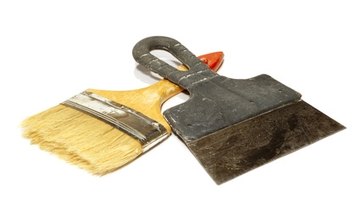Primitive Paint & Stain Techniques
Primitive decor has an aged, worn appearance that embraces imperfections and is most often present in country-rustic decorating. Nicks, scratches and chips are desired characteristics. Create primitive home furnishings from handmade or recycled pieces. Many times the finishes of such pieces do not have a primitive style; but with the addition of primitive paint and stain techniques, you can transform your home decor into aged prims without expensive tools or harsh chemicals.
Distressed Dry-Brushing

-
Apply a base coat to the furniture or accessory you are aging using an old paint brush with thick, ratty bristles. The paint strokes will be noticeable, with raised streaks. The coat does not need to have complete coverage. Allow the paint to dry.
-
Sand the piece with coarse sandpaper to faintly and randomly expose the wood beneath the paint. Sand the piece more heavily on the edges and on areas where wear would happen naturally over time. Wipe the surface with a dry rag.
-
Dip the old brush into your chosen topcoat paint color. Wipe most of the paint from the bristles onto a paper towel. Lightly stroke the dry brush over the sanded surface. This results in light stroke marks with a faded appearance. Make heavier strokes or go over previous ones if the paint is too light. Continue until the whole piece has been painted. The paint will dry almost immediately.
-
Sand the painted surface again to age the topcoat. If the piece is a tray or a table and will be used for serving food or drinks, spray the surface with a clear matte sealer. This will allow the surface to be wiped clean. Otherwise, a sealer is optional.
Rusty Paint Finish
-
Spray-paint the item with flat brown paint or primer. Allow the paint to dry.
-
Pour an even amount of brown acrylic paint and orange acrylic paint on a paper plate. Dip a stencil brush into both paints and pounce the two colors together on the plate to mix them partially. Randomly pounce the paint onto the primed surface to give the appearance of heavier rust in some areas more than others.
-
Mist the painted surface with flat black spray paint to finish the rusty-aged technique.
Pickle Staining
-
Sand the finish of your wood piece to remove the shiny varnish and give the surface tooth to accept the stain. Wipe the surface with a dry rag.
-
Mix a quart of white primer or flat acrylic paint with a cup of water. If mixing a smaller amount of pickling stain, mix four parts primer to one part water.
-
Paint the sanded wood piece with your pickling stain mixture using a sponge brush. Wipe off the stain with a clean rag following the grain of the wood. Add more stain, if needed, for the desired finish.
Primitive Weathered Look
-
Mix equal amounts of black, light gray and dusty sage acrylic paint with water. Add water until the consistency is slightly thicker than milk.
-
Brush the stain mixture onto new, unfinished wood or to the cut edges of weathered barn wood using a sponge brush.
-
Allow the stain to soak in a few minutes. Wipe off the excess with a clean rag. Repeat the application until you've achieved the desired shade.
Tips
- Oil-based paints are not recommended for techniques that involve sanding. The paint tends to get sticky on the sandpaper and create smeared smudges on the item you are sanding. As a general rule, if the instructions on the can do not say to clean up with water, it is best not to use that paint for sanding projects.
Writer Bio
Based in the Midwest, Cyndee Kromminga has been writing craft and interior design articles for 15 years. Her articles and craft designs have appeared in Crafting Traditions Magazine, Easy Holiday Crafting Series-House of White Birches Newsletter and Country Woman Christmas Books. Kromminga's education is in interior design and she has experience operating a craft and design business for more than 20 years.
Photo Credits
- paint image by Aleksandr Ugorenkov from Fotolia.com
More Articles



